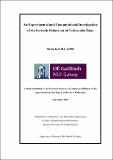| dc.description.abstract | Achieving sufficient initial implant stability is of paramount importance for orthopaedic device longevity. In order to improve the design of orthopaedic devices it is essential to gain a better understanding of the mechanical behaviour of the peri-prosthetic bone, both during and following implantation. The overall aim of this thesis is to provide a better understanding of the post yield behaviour of trabecular bone using experimental and computational analyses, and to investigate the importance of multiaxial trabecular bone plasticity in the implantation and failure of orthopaedic devices.
An initial investigation of full and surface cementation techniques of the tibial component in total knee arthroplasty reveals a multiaxial stress state in the peri-prosthetic trabecular bone. High von Mises stress and pressure stress computed in the trabecular bone motivates the investigation of the multiaxial post yield behaviour of trabecular bone. Samples of natural and synthetic trabecular bone are tested under confined compression loading conditions. The ability of the Drucker-Prager, Mohr-Coulomb and crushable foam plasticity formulations to predict the experimental behaviour is investigated. In the case of the crushable foam plasticity formulation, increased pressure stress during confined compression results in material yielding followed by a stress plateau, as observed experimentally. In contrast the Drucker-Prager and Mohr-Coulomb plasticity formulations fail to capture the experimental results, as increased pressure stress inhibits material yielding. The role of the trabecular bone microarchitecture in the apparent level multiaxial yielding of trabecular bone is then considered using micro-computed tomography based finite element models.
iii
Following this, two macroscale orthopaedic device applications that involve multiaxial trabecular bone plasticity are considered: the subsidence of a vertebral interbody fusion device; and the press-fit stem implantation of a tibial component. Continuum based pressure dependent crushable foam plasticity formulations accurately predict the subsidence forces and plastic zone size, observed during device subsidence. It is also demonstrated that the crushable foam plasticity formulation provides accurate predictions of implantation forces for tibial component implantation. Additionally, the importance of friction at the implant-bone interface is highlighted.
The work presented in this thesis provides insight into the multiaxial post yield behaviour of trabecular bone. The implementation of continuum based crushable foam plasticity formulations for the simulation of the inelastic behaviour of trabecular bone may aid in the future analysis, design and development of orthopaedic devices. | en_US |


